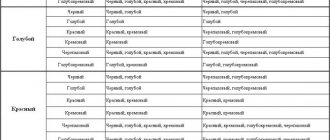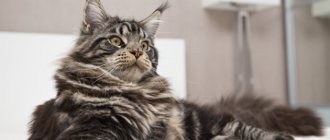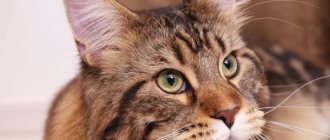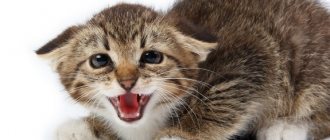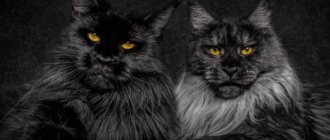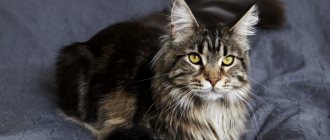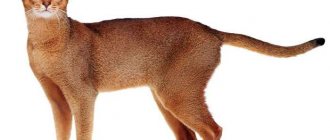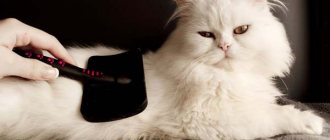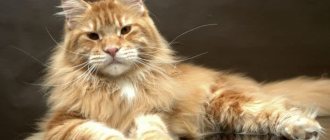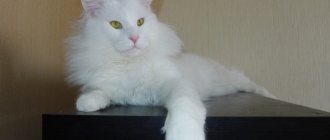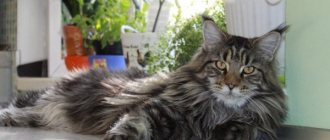Origin story
The history of the birth of Maine Coons is still surrounded by myths and legends, although it has already been genetically proven that their ancestors were born without human intervention.
But what breed these ancestors were - the question remains open. According to one of the legends, among the relatives there are Norwegian Foresters. These large animals, adapted to life in harsh conditions, were brought on their ships by the Vikings traveling across the seas and oceans in the 11th century.
There is another legend: Marie Antoinette, preparing to flee the country, in addition to the necessary things, loaded onto the ship her favorite cats - the largest and fluffiest. The escape was unsuccessful, but the ship and the cats still set off. They were landed on a new continent, where the animals went wild and changed significantly in appearance.
The most popular version goes like this: from time immemorial, Maine Coons lived on the American continent, next to people, and gradually moved closer to them. Since 1850, wild, long-haired giants began to be exhibited at fairs, and in 1861, a cat named Captain Jenks-of-the-Marine-Cavalry became the first officially recognized Maine Coon.
In 1967, a standard for the breed was adopted, and in 1980 the number of owners exceeded a thousand. In the wake of renewed interest around the world - the USA, Russia, Europe - nurseries began to open and Maine Coons entered the top ten most popular cats in the world.
In some sources you can still find the old name of the breed - the Manx raccoon cat. It sounds funny, but it’s true: it was once assumed that the birth of Maine Coons was the result of a “romance” between a raccoon and a cat.
History and standards
The Maine Coon is a native breed of cat that originated from cats living on the farms of Northeast America in Maine. Initially, only black tabby cats were called Maine Coons. Due to their coat color, powerful build and huge tail, these cats looked like raccoons (hence the name of the breed - literally “Maine raccoon”. “Maine” is the name of the state of Maine, “coon” is the second part of the word “racoon”, that is “ raccoon").
Maine Coon cats are distinguished by their friendly nature and especially large size. Among domestic cats, this breed is one of the largest in the world: males can weigh from 7.5 to 15 kilograms, females from 4.5 to 8.5 kilograms, and animals of some breed lines reach 12 kilograms or more. Although Maine Coons have long hair, cats of this breed do not require frequent brushing, like Persians. The body length of an adult representative of the breed, as a rule, exceeds one meter (the maximum length reaches 1.23 meters). As breeders note, a healthy Maine Coon eats several times more than an ordinary domestic cat, preferring fresh food to dry food.
The harsh winters of New England favored the survival of fairly large cats with long hair. The “first” Maine Coon is considered to be a cat named Captain-Jenks-of-the-Sea-Cavalry. It was shown at exhibitions in Boston and New York in 1861 and marked the beginning of the early popularity of the breed, but at the turn of the 19th and 20th centuries, Maine Coons were surpassed by the fluffier Persians. The Maine Coon as a breed managed to survive only because farmers paid tribute to its size and excellent hunting qualities. On the Isle of Man, in 1993, a coin was issued dedicated to the Maine Coon breed. The 1 crown (25 pence) coins were made from cupro-nickel, silver and gold.
Maine Coon breed standard in the WCF system.
Body and size: The largest breed among domestic cats (some individuals reach 15 kilograms in weight). The maximum recorded body length is 1.23 meters. Large to very large, muscular, elongated and broad-boned body of a rectangular format. The muscular neck is of medium length. The limbs are of medium length, strong, muscular, the paws are large with tufts of hair between the toes. The tail is long, at least to the shoulder, tapering to a pointed tip, covered with flowing hair.
Head: Large, massive, straight, sharp outlines. High cheekbones, medium length nose.
Ears: Very large, wide at the base, pointed, set high, almost vertical. The distance between the ears is no more than the width of one ear. Brushes protrude beyond the edges of the ears; tassels on the ears make Maine Coons look like a lynx.
Eyes: Eyes are large, round, slightly slanted, and can be amber, golden, green or yellow.
Coat: The hair is short on the head and shoulders, except for the collar, and distinctly lengthens along the back, sides and belly. The thick undercoat, soft and fine, is covered with coarser, dense hair. The thick, free-flowing, water-repellent topcoat extends to the back, sides and top of the tail.
Colors: Chocolate, brown and corresponding weakened colors (lilac and fawn) are not accepted in any combination, nor are acromelanic colors accepted. All other colors are recognized.
Personality: Friendly, peaceful and flexible. Maine Coons are very careful - if there is an obstacle in the animal’s path, it will not throw it off, but go around it. If there is a scratching post, the furniture will be fine. The Maine Coon does not like narrow spaces, so it does not climb anywhere. Despite its large size and slightly menacing appearance, this breed has a particularly affectionate character. They easily adapt to the owner and the habitat in general. By nature, the Maine Coon is a good-natured and active pet. Very loyal to “their” family, but careful with strangers.
Faults: The coat is the same length throughout the body - a significant fault, which, even with excellent structure, prohibits the CAC title.
Rating scale: Body 35 points, head 30 points, coat color and texture 25 points, eye color 5 points, general appearance 5 points.
Maine Coon breed standard in the TICA system.
Head.
Shape: Broad, modified wedge, medium in size with a strongly rounded forehead and high prominent cheekbones. A clear stop should be felt under the cheekbones.
Eyes: Large, slightly oval, appearing almost round when wide open. Wide set. Located slightly obliquely in relation to the outer edge of the ear. Color is any shade of green and/or gold, blue or odd-eyed for white animals. There is no relationship between coat color and eye color.
Ears: Large, high, wide at the base. In relation to the head, the posture is high and tilted slightly outward. The distance between the ears should not be greater. Than the width of the base of the ear. The lower base is located slightly further back than the upper. Moderately pointed. Lynx tassels continue vertically upward from the back of the ear. The pubescence of the ear continues horizontally beyond the outer border of the ear.
Chin: Straight, in line with the nose and upper lip.
Box: Square.
Profile: Gentle concave slope. Some convexity at the end is allowed.
Neck: Of medium length, with strong muscles.
Body.
Body: Large, long, rectangular, but not thin.
Feet: Medium proportions in relation to the body with strong bones and muscles.
Feet: Large, rounded, with tufts of hair between the toes.
Tail: Wide at the base and tapering to the tip, finely feathered, with flowing hair, no less than the length of the body to the base of the tail.
Backbone: Powerful.
Muscles: Strong, strong.
Wool/Color/Pattern.
Length: Uneven, shorter at the shoulders, gradually lengthening towards the belly and “pants”. In front there is a long collar-mane around the neck, the belly and pants are very shaggy. A full collar is not necessary, but it is advisable that it starts from the base of the ears.
Texture: All-weather wool. The coat fits tightly to the body, flowing smoothly along the body. There is a light undercoat, but not cotton or wool-like.
Color: Traditional categories, all divisions, all colors. White lining around the eyes, lips and chin is acceptable, with the exception of solid colors.
Important Note:
Female cats are proportionally smaller than female cats and can weigh 2-3 kg less. Allowance must be made for this significant difference in size. Adult cats may have larger and wider heads than female cats.
Penalized:
Sharply expressed whiskers. Protruding chin. A dip or severe bulge at the end of the nose. Insufficient amount of undercoat. Single specks, medallions or spots. Straight profile. Wide-set or loose ears. Long skinny legs. Slanting almond-shaped eyes. Flat edge of the upper eyelid when the eye is wide open. Insufficiently shaggy belly. Short tail. Round head. The coat is the same length throughout the body. Short stocky body. Light frame. Small size of the animal overall.
Rating scale:
HEAD 37 points: Shape 12. Eyes 5. Ears 10. Box and chin 5. Profile 3. Neck 2. BODY 38 points: Body 10. Paws 10. Tail 10. Bones 5. Muscles 3. COAT/COLOR/PATTERN 25 points : Length 10. Texture 10. Color 5.
Maine Coon breed standard in the FIFe system.
Body: The physique of cats and cats of this breed is large, the head has a square line and large ears. The neck of cats and Maine Coon cats is muscular and strong. The body of cats and cats has a rectangular shape, muscular, strong and long with a wide chest, massive bones, and a long flowing tail. The feeling of strength and power is created by their density and good muscle tone.
Head: The head shape of Maine Coon cats and cats is medium in size with square lines, a profile with a slightly concave transition and a gently rounded forehead. The cheekbones are prominent and high. The muzzle has a square line, with a nose and face of medium length. There should be a correct and clear transition between the muzzle and cheekbones. On the vertical line of the upper lip and nose is a strong chin.
Eyes: On the muzzle there are wide-set, large, slightly oval eyes; when wide open, they appear round. The eyes are located slightly at an angle. Maine Coon eyes can be any color. There is no relationship between coat and eye color. It is advisable if the eye color is clear.
Ears: Wide at the base, large, slightly pointed with yellowish tassels. The tassels of hair that are located in the ears protrude beyond the outer border of the Maine Coon's ears. The ears are located high on their head with a slight inclination outward. The distance that should be between the ears corresponds to the width of one ear. With age, the distance between the ears increases slightly.
Limbs and paws: The legs of cats and cats of this breed are of medium length, very strong, together with the body they form a rectangle. The paws are round, large, and have tufts of hair between the toes.
Tail: The tail is equal to the length of their body - from the shoulder blades to the base of its tail. At the base of the tail it is wide, which tapers towards its tip. The hair on the tail is flowing and long.
Coat: The structure of the Maine Coon coat is “all-weather”, thick. On the head, shoulders and legs the hair is short, which gradually lengthens towards the lower back and sides, with a fluffy belly and baggy, long and shaggy pants on the hind legs. There may also be a collar. The Maine Coon's coat has a silky texture. Their undercoat is thin and soft, which is covered with smooth and coarse hair.
Color: Maine Coons come in all color variations, with white including all pattern variations. Patterns such as lilac, chocolate, fawn, point and cinnamon are excluded. The amount of white color can be any - this is a white medallion, a white star, a white collar, white on the belly, white on the paws, etc.
Standards
The appearance of Maine Coons clearly bears the imprint of the climate where their ancestors previously lived.
Wide paws with dense tufts of hair between the toes allowed, as scientists suggest, to vigorously stomp on snow crust without falling into snowdrifts, and the thick undercoat allowed them to survive in the snowy and cold continental winter.
| Standard | Description |
| Head | Large, massive, with clearly defined cheekbones and a nose of medium length. |
| Neck | Muscular, strong, long. |
| Eyes | Round, set wide and slightly oblique. The iris can be colored in different shades of yellow and green. |
| Ears | Large, slightly inclined forward. In the auricle, hair grows in tufts, as on the tips of the ears, forming tufts. To protect themselves from the wind, cats press their ears to their heads, as if folding them. |
| Torso | Long, with well-developed bones and muscle mass. The back is flat, the chest is wide. |
| Paws | Wide set, muscular and very strong. The paw pads are round, protected by a dense “edge”. |
| Tail | Without kinks or bends, with a wide base. Covered with a thick layer of wool and serves as a source of additional heating. Its length is equal to the length of the body. |
| Wool | The coat grows unevenly. In the area of the hind legs it grows more densely, forming “pants”, in the neck area – a shaggy “collar”. On the back the coat is coarser (guard hairs predominate). A downy and very soft undercoat grows on the sides and belly. |
A ban on participation in exhibition events is imposed on an animal that has the following defects in appearance:
- Evenly growing hair on the body;
- Depression on the bridge of the nose;
- Short or crooked tail;
- Small size of the animal;
- Specks and spots on the fur;
- Insufficiently fluffy fur in the belly area;
- Having extra toes on the paws.
Pictured are Maine Coon kittens
TICA system
This American system works with breeders of a recognized breed, not organizations. In terms of the number of members, it ranks second among felinological associations. The main office is located in the USA. At the exhibition, the judge is not told the name of the cat owner, nor the name of the animal with its titles.
There is no significant difference between the description of the breed and the previous system. However, some nuances are present.
In the TICA system, the standard provides the following specified characteristics:
- The head in profile resembles a modified wedge;
- Coon ears are moderately pointed;
- The angle between the outer edges of the ears is indicated;
- A hump on the nose bar of kittens is allowed;
- The size of cats can differ significantly from the dimensions of male cats;
- The width of the body is equal from the chest to the hips;
- The undercoat should not look like cotton or topcoat.
Useful to read: Maine Coon cat in heat
Coons with the following signs are fined:
- Wide open eye;
- Slanted or almond-shaped eyes;
- Narrow, sloping chin;
- Ears that are close-set and flame-shaped in shape;
- Medallions in any color;
- Narrow body;
- Short tail;
- Straight nose or convex end;
- Sparse coat and undercoat.
Maine Coon will be disqualified in the following cases:
- Scratching and biting cat;
- Bilateral cryptorchidism;
- Polydactyly;
- Strabismus;
- Presence of the xiphoid process;
- Lack of tail (complete or partial);
- Small sizes of cats and cats;
- Tail creases;
- Complete blindness;
- Excessively small breasts in diameter.
This standard contains a grading scale. The main criterion is the head is assessed with a maximum number of points - 40, body - 35, coat along with color and pattern - 25. Each Maine Coon is examined in stretching. The criteria are divided into points of 5-10 points. It is stated that other breeds cannot participate in the breeding of Maine Coon Cats.
Dimensions and weight
Modern representatives of the breed have become even larger in size, their ears have grown, and their muzzles have elongated even more.
Dimensions
The height of an adult Maine Coon, as a rule, does not exceed 25-41 cm, with a total body length with tail of up to 100-110 cm.
According to the Guinness Book of Records, the title of “Longest Cat” belongs to a Maine Coon cat named Stevie - 123 cm.
Weight table by month
The average weight of a male is from 7 to 11 kg, females - from 4.5 to 7 kg.
| Age | Cat | Cat |
| 1 Week | 180-230 g | 200-260 g |
| 2 | 280-340 g | 300-360 g |
| 1 month | 560-680 g | 630-750 g |
| 2 | 1.15-1.4 kg | 1.23-1.5 kg |
| 3 | 1.7-2.3 kg | 1.8-2.3 kg |
| 4 | 2.7-3.6 kg | 3-3.8 kg |
| 5 | 2.9-3.9 kg | 3.2-5.5 kg |
| 6 | 3.2-4 kg | 3.9-6.5 kg |
| 7 | 3.5-4.3 kg | 4.2-6.5 kg |
| 8 | 3.8-4.3 kg | 4.5-6.9 kg |
| 9 | 4.1-5 kg | 5-7 kg |
| 10 | 4.2-5.5 kg | 5.2-7.5 kg |
| 11 | 4.3-6 kg | 5.7-8 kg |
| 1 year | 4.5-6.3 kg | 5.7-9 kg |
| 1.5 | 4.5-6.5 kg | 6-9.5 kg |
| 2 | 4.5-7 kg | 10 kg |
| 2.5 | 4.5-7.2 kg | up to 12 kg |
| 3 | up to 7.5 kg | up to 13kg* |
* up to 13 kg - the weight of a castrated cat.
History of the breed
The origin story of the Maine Coon is steeped in myths and legends. However, most of them are not documented.
Unlikely:
- Domestic cats interbred with raccoons. Due to the characteristic marbled color, the breed received another name: the Maine raccoon cat. In their homeland, Maine, they are still called Maine raccoons. Such hybridization is simply not possible, but there is a legend.
- The second unlikely version is that Maine Coons descended from lynxes and feral domestic cats.
More plausible:
- The origin of Maine Coons is associated with the cats of the French queen Marie Antoinette. During the French Revolution, she wanted to save not only herself, but also her 6 Angora pets. She gave the animals to a military man who went to America and settled in Maine (Northeastern USA). From 6 cats, after crossing with local ones, the modern breed arose.
- Some researchers associate the origin of the breed with Norwegian forest cats, which came to the continent with the Vikings around the 2nd century.
- Another part believes that the breed was developed after Asian cats arrived on the continent. They were taken on board by sailors to catch rats. And after landing, they were released ashore, where they gradually spread.
- According to another legend, the cabin boy Tom Kuhn sold long-haired cats to the owner of the Tarbox farm in Maine. This is where these large animals were bred.
Most felinologists believe that Maine Coons are aboriginal cats native to North America, living on farms where they were kept to catch mice. Local residents crossed short-haired species with other cats, presumably Angora or Persian, to obtain the Maine Coon. This cat breed is also called the North American Semi-Longhair. She quickly gained popularity.
Maine Coon breed photo
Official recognition came in 1908. However, in 1911, the popularity of Maine raccoons was eclipsed by Persian cats. For almost half a century, the breed went into the shadows, and only thanks to farmers, it was possible to preserve it.
The description of the Maine Coon breed was recorded in the 1967 standard. And from the same year, the Maine cat began to regain titles and first places at exhibitions. In 1976, Maine Coons were officially recognized by the CFA. Then, with minor differences, the standard appeared in all feline systems: WCF, ACF, GCCF, FIFE, TICA, ACFA.
Colors
Maine Coons have two genetic colors - red (red) and black. The rest are their shades or lightened versions. The documents use a special EMS color coding.
In the photo there is a Maine Coon cat: black color
Maine Coons are divided into several groups based on color: those with a pattern (tabby), without a pattern (solid), tortoiseshell, silver and smoky.
Components of a tabby pattern:
- the letter "M" on the forehead;
- the mirror of the nose and eyes are outlined in dark;
- horizontal stripes on the paws, and small spots on the stomach;
- “necklace” on the chest made of stripes.
Tabby types:
- Classic (marble): stripes are drawn along the spine, there is often a “butterfly” between the shoulder blades, and rounded marks on the sides;
- Spotted: dotted stripes or small spots;
- Brindle: dark stripe on the back, vertical lines along the sides;
- Ticked: an atypical color found in more eastern breeds. The pattern is marked only on the muzzle, the tip of each hair is painted in a dark color.
The color of solids can be: red, red, black, blue, cream, white. Tortoiseshell: torti (cream) or toby (black, brown, red).
In the photo there is a Maine Coon cat: red color
What does a Maine Coon look like?
Maine Coons were originally brought to the very harsh climate of Maine, which influenced their appearance. To survive in such conditions, they developed dense, thick and long hair to protect them from frost, and special pads on their paws for moving through snowdrifts. The large size is due to the need for hunting. Now even in the photo the Maine Coon looks cute, and it’s hard to say that he was once a tough hunter.
Muzzle
The head has an elongated shape and massive dimensions. This was required for the ancestors to “dive” into holes to catch rodents.
The color of the eyes always depends on the color of the coat: it can be blue, greenish and even yellowish. The shape of the eyes is round, slightly slanted.
The ears have a dense cartilage structure, abundant hair, and “lynx tassels.” Thanks to these differences, cats could easily hunt rodents and small game. For this, American farmers loved them very much. Also, to protect themselves from the cold, cats use an interesting method unique to them. They close the ears very tightly to prevent cold air and wind from entering there.
Body type
The neck is elongated, of medium length, large and very muscular (especially in males). There is a so-called “collar”, which is very highly valued by breeders. The fuller the collar, the more expensive the kitten can cost.
What does a Maine Coon look like in proportions? The long body with good hair is somewhat reminiscent of a rectangle. The muscles are well developed and there is also a strong skeleton. The limbs are large and massive, with abundant hair.
The tail is long and fluffy. Equal in size to the length of the body. Some representatives may have stripes characteristic of a raccoon. In the past, Maine Coon tails served as heaters in extreme situations. Because of its length, cats could easily wrap it around their entire body and keep warm.
Coat and color
The wool is long, on average 10-13 cm, and has water-repellent properties. On the tummy, vellus hair takes up more space, and on the back there are only coarse hairs. The hair grows from the head to the panties and serves to warm the body from cold weather.
The color of Maine Coons is quite varied. It differs in several categories:
1. Drawing
2. Coat color
3. Presence or absence of stains.
Maine Coon coat colors are black, white and red. Sometimes the colors may "mix" a little. The pattern is tiger, marbled and spotted. The spots are not always present and can be located on different parts of the body. Most often they are located on the paws, muzzle, neck and ears. Maine Coon color varieties offer a wide range of variations, and the breed has not suffered from excessive interference by breeders.
Character and habits
The size of the Maine Coon, as well as its serious appearance, can cause some caution and even fear. The tassels on the ears, huge paws with long claws, the “sullen” expression of the muzzle suggest that this furry giant has a stern disposition, and his character is so unkind that you need to keep your “ears on the alert” all the time. But this is a mistaken opinion. Behind the appearance of an unsociable forest giant hides a kind soul and an almost angelic disposition.
Breeding work was and is being carried out with full responsibility on the part of nurseries and breeders, and attention is paid not only to appearance, but also to psychological characteristics of character. Individuals that are closed, nervous, cowardly, and even more so aggressive, are excluded from the breeding process.
The Maine Coon is a friendly and accommodating animal. There is not a drop of isolation or selfishness in him, they do not like to exist on their own, do not strive for solitude. He prefers pleasant company to solitude, and gets along well not only with people of all ages, but also with other cats and even dogs. However, it’s still not worth letting small rodents and birds out for free range: no matter how sweet the Maine Coon is, the passion of a hunter boils in his blood.
From the whole family, he chooses as leader not the one who is stronger, but the one who feeds him and plays with him. But not intrusive. Having a keen sense of human mood, he knows how to guess the moment and stick his head in for “scratching” at the most convenient time. Loves to lie next to family members on the sofa or at their feet.
She always meets the “leader” from school or work and shares with him her impressions of the events of the past day.
They are patient and very affectionate towards children; it is not for nothing that they are also called nanny cats. Even if the baby hurts him, the Maine Coon will not allow himself to let out his claws and bite the fool. The animal will simply turn around and move aside.
Despite their even temperament, Maine Coons are not lazy lovers of lying on the couch and lying in the sun. Their nature requires movement, play and learning. Therefore, do not spare money on a special play complex in which your pet will be able to climb and scratch his claws to his heart’s content. Otherwise, the situation in your apartment will suffer.
Are a cat's pupils the same during the day and at night?
Not really
Maine Coons need walks in the fresh air. They wear harnesses calmly and do not protest against leashes, unlike many cats. It is better to avoid noisy streets, but a quiet square, or a forest or a summer cottage is just right. There the cat will be able to climb trees to his heart’s content and hunt.
Maine Coons are not vindictive or touchy. Even if you scold him for his pranks, they will listen to it calmly, but they will not pee in their shoes in retaliation. Even if you step on his tail, he will quickly forgive you (but you will still have to apologize).
They are inquisitive and easy to train. They quickly learn to press doorknobs, use the toilet for its intended purpose, move the TV remote control with their paw, or carry a magazine in their teeth. They love to rinse their paws in a bowl of water or catch a stream from the tap, which means that they have no problems with bathing. But they eat extremely carelessly: they pick up pieces from the bowl and throw them directly on the floor, so they have to clean up after them often.
They aren’t afraid of strangers, but they don’t even try to approach them to make acquaintances—they are indifferent.
Expert opinion
Dusheba Vera Ivanovna
In 2010, she graduated from the Moscow State Academy of Veterinary Medicine named after K.I. Scriabin with honors, specializing in veterinary medicine. I regularly attend veterinary conferences, congresses, and webinars.
The Maine Coon needs a lot of space, so a small apartment to keep it - alas! – doesn’t fit.
Maine Coon character
In general, the Maine Coon breed can be compared to a dog. These cats are very loyal to their owner, kind and very often follow him like a tail. They also have warm feelings towards other family members, so this breed can be called one of the friendliest and sociable.
Many people mistakenly believe that the Maine Coon’s character is angry and stern, looking at its face, but they do not even suspect that behind such an appearance lies simply an angelic disposition.
Maine Coons love to take funny poses and make unusual sounds, but they meow quite rarely. The temperament of males and females has quite strong differences:
- Males are less affectionate than females. During the heat period, Maine Coons can be a little aggressive and mark their territory, which becomes an unpleasant problem for their owners. The solution is castration.
- Cats are more affectionate, they love to be close to their owner. Often choose a place at the feet. During estrus they do not show aggression or other unpleasant character traits.
Both females and males have a neutral attitude towards guests in the house, but they will not be particularly happy if someone else begins to pay a lot of attention to them. Coons are very caring parents, so after the birth of their offspring, they do not leave their kittens for a minute, constantly looking after them.
Although this breed is very attached to family members, they also love independence. Maine Coons choose high places for themselves so they can watch everyone comfortably. Cats are not particularly playful, but no one can be immune from torn wallpaper, broken pots and chewed wires, so it is better to accustom them to scratching posts from childhood and monitor their behavior.
Coons will treat children calmly. But do not forget that it will be unpleasant for the animal if its tail or whiskers are pulled. Therefore, children need to be told in advance that the new family member should be treated carefully and affectionately. If you have a newborn baby, and the cat has been living with you for a long time, then there is no need to worry. Maine Coons are good with small children and will not show aggression or jealousy. And when the child grows up, the pet will not mind accepting him into his company.
These giant cats are not aggressors. They can easily get along with other cats and even dogs, because the hunting instinct in them has almost died out, and in the past they only hunted rodents and snakes.
Care instructions
Buy wood filler: it absorbs urine perfectly, absorbs odor, and is very inexpensive. Choose a tray that is large and open (in “houses” the filler takes a long time to dry).
Wool
Regular grooming will help you maintain a luxurious coat: combing out excess fur a couple of times a week, and 3-4 times during shedding (1-2 times a year). Two combs will help you with this - one with wide teeth, one with frequent ones - and a brush with natural bristles. The tangles can be sorted out by hand or cut off (but you shouldn’t let this happen, because Maine Coons’ hair grows back very slowly).
Bathing
Cats are bathed either before a show, or if he gets dirty, or if he sheds heavily. Water - warm (not lower than +38), washing shampoo - only cat shampoo, dry first with a towel and then with a hairdryer. You can’t rub the fur, otherwise it will get tangled!
Teeth
If your pet eats natural food, its teeth should be brushed at least once a month; if you buy industrial dry food, it should be brushed once every 2 months. Buy a special brush, as well as a special toothpaste.
Eyes
If discharge appears in your eyes, wipe them with a cotton swab soaked in a weak solution of boric acid or tea leaves (there are also eye lotions in pharmacies). At other times they should not be touched.
The same applies to the ears: apart from monthly preventive cleaning, no additional manipulations will have to be done.
Claws
The Maine Coon takes care of its claws on its own. Your help will only be needed if the cat breaks a claw. Trim it with a nail clipper or tweezers.
Care and maintenance
Maine Coons can be brushed at home as needed; this should not be a problem. Particular attention should be paid to the areas on the back and sides - the fur is thicker there and tangles can form. You should also arrange bathing procedures once every three to four weeks. Maine Coons are not afraid of water, so there should not be any problems. Make sure to choose the right shampoo so that it does not harm the animal.
The inside of the cats ears should be pinkish. Pet stores sell special wipes for ear and eye hygiene. But you can clean them using a soft cloth or napkin.
To protect yourself from damaged wallpaper and scratches, and also to help your cat with claw points, you need to give your pet a manicure and pedicure once a week.
For Maine Coons, you should purchase a tray that has a larger area than standard ones. It is also recommended to buy closed trays, as some representatives of this breed like to scatter the filler, burying “their business.”
The general rules for caring for and maintaining a Maine Coon are no different from the rules for caring for any long-haired cat. Trimming the claws, cleaning the ears, eyes, teeth and regular brushing is all that is needed for a giant cat.
Catering
The diet must meet all the natural needs of the Maine Coon, be nutritious and easily digestible.
Natural products
Main components:
- Proteins (proteins) are necessary for growth, muscle contraction, strengthening the immune system;
- Lipids (fats): deficiency causes many diseases;
- Carbohydrates: a source of energy, stimulate the gastrointestinal tract, activate metabolic processes;
- Polysaccharides: another source of energy and building material for the body;
- Minerals, vitamins, taurine.
Natural menu includes:
- Meat: veal, beef, rabbit, lamb, poultry (chicken, turkey). Pork and duck are not suitable: they are poorly digestible and can be infected with parasites.
- By-products: liver (boiled), hearts, ventricles, chicken necks, tripe.
- Sea fish: hake, salmon, salmon.
- Fermented milk products: cottage cheese, natural yogurt, sour cream, cream, fermented baked milk, kefir. Non-greasy, without dyes and chemical additives.
- Hard unsalted cheese.
- Porridge: buckwheat, oatmeal, rice, semolina (liquid for kittens), pearl barley, millet. Boiled in water, without sugar or salt.
- Unrefined sunflower or olive oil - a few drops per day with porridge.
- Vegetables: pumpkin, zucchini, green beans, carrots, cucumber, greens (lettuce, parsley).
- Sprouted wheat or oats.
Water: fresh and clean, at room temperature. Change it every day, morning and evening.
Expert opinion
Dusheba Vera Ivanovna
In 2010, she graduated from the Moscow State Academy of Veterinary Medicine named after K.I. Scriabin with honors, specializing in veterinary medicine. I regularly attend veterinary conferences, congresses, and webinars.
In the first month, kittens eat 6 times a day and only mother’s milk (either goat’s milk or special food from a pet store). At 2-3 months, you can start supplementing with porridge with milk, stewed vegetables, egg yolk, cottage cheese and fermented baked milk. From 4 months to 6 months, kittens eat 4 times a day, and from six months - 2 times, in the mornings and evenings. Pregnant cats, weakened and sick animals have an individual diet.
It is allowed to give the cat a special paste to remove swallowed hair from the stomach, as well as brewer's dry yeast and vitamins, but only on the recommendation of a doctor and in the dosage specified by him.
It is forbidden to give cats:
- Bones, tripe, lard, skin and fat;
- Whole cow's milk;
- Smoked, salty, sweet, fatty;
- Baked goods and flour products;
- Potatoes, eggplants, peas, soybeans;
- Chocolate;
- Alcohol, juices, mineral water, tea, coffee;
- Condiments, sauces, ketchups and mayonnaise.
Recommended food
Commercial food (both dry and wet) helps save time while still providing your pet with quality nutrition. Wet ones are more expensive, but are absorbed faster and have a more nutritious composition.
There are many brands selling food, but remember: do not buy economy or premium food. Despite their low price, they often cause allergies, their composition is poor, and the percentage of mineral salts and high-quality meat is extremely low. Examples of quality food: Pronature Holistic, One&Only, Schesir.
Below are recommended super premium and holistic foods. Links with the names of the food are clickable, on them you can, within our website, get acquainted with the descriptions of the food and read reviews from owners of the Maine Coon cat breed.
| Super premium | Holistic | Super premium |
| Sanabelle | Carnilove | Naturea |
How much does a Maine Coon cost?
The average price of a Maine Coon fluctuates around 20,000-50,000 rubles, but this is not always the limit. It all depends on the class of the kitten and its gender. Animals of breeding class and show class (for breeding and exhibitions, respectively) will cost more. But the pet class will cost less (these are pets).
It is worth noting that males are more expensive than females. If an individual has a rare coat color, the price will rise. The price may even depend on the level of the nursery. The cost is due to expensive maintenance. Therefore, there is no need to skimp and purchase an animal at the poultry market or respond to incomprehensible advertisements. Healthy and vaccinated Maine Coon kittens will definitely please you with their beauty, kindness and affection!
Diseases
The Maine Coon breed is aboriginal, which means that it developed independently, and no serious genetic mutations occurred in their bodies. Unlike, for example, the same Orientals or Persians. However, Maine Coons can also get sick.
The most common ailments:
- Hip dysplasia: causes hip dislocation and pain. Not fatal, but extremely unpleasant.
- SPA (spinal muscular atrophy): this disease is much more serious. Does not allow you to lead a lifestyle that suits your habits: running, hunting, playing. Leads to early death.
- Hypertrophic cardiomyopathy: thickening of the heart wall. Leads to sudden death. There are no symptoms, the only thing that can be done is to identify such a disease in the cat's pedigree.
- Parasites and infectious diseases: By maintaining hygiene and vaccinating your pet on a schedule, you can significantly reduce the risk of contracting the disease.
- Joint diseases: if a Maine Coon doesn’t move much and eats a lot, it will soon begin to have problems with its joints. Good muscles require constant exercise.
- Oral diseases: stomatitis, gingivitis and others. Take your pet to the veterinarian regularly for examination. If you need laser teeth cleaning, don’t refuse.
- Urolithiasis: a common illness. Provoking factors: hard water; incorrect ratio of fish and meat (there should always be more meat, and fish is given no more than once a week!).
- Indigestion: if you feed your coon with leftovers from your table, give him salty, smoked and similar food that is absolutely not suitable, your pet will never stop having stomach and intestinal problems.
Polydactyly stands apart - extra toes on the paws. This does not interfere with their lives, but their owners do not fall into the breeding and exhibition categories.
Maine Coon Health
Possible diseases
This breed has very good immunity and does not have many diseases compared to others. However, these large cats also suffer from some ailments.
1. Maine Coons have very sensitive digestion, which can often cause stomach upsets. But you can protect yourself and your pet from this if you choose high-quality food. If you feed your pet food from the table, then you should limit its consumption of fatty, spicy and salty foods, or it is better to exclude such food altogether.
2. Kidney disease or urolithiasis. Happens quite often.
3. Diseases of the joints. Most often, individuals living in apartments and leading an inactive lifestyle are affected. Therefore, you should buy your pet some toys with which he can spend part of his day. This will reduce the risk of joint problems.
4. Hypertrophic cardiomyopathy. Refers to genetic diseases. It is very difficult to identify the disease, because it does not manifest itself externally, so you need to take your pet to a veterinarian-cardiologist for preventive examinations.
Maine Coons may develop diseases that are common in other breeds. Any deviation from norms of behavior may indicate the initial stage of the disease. In general, the health of the Maine Coon can be considered exemplary.
Reproductive health
The female coon's estrus begins between 6 and 9 months, but the animal is not bred during the first estrus. It is necessary to wait until the age of 1 year, and for the first time find a more experienced male. Two inexperienced animals are usually not bred.
Mating is prescribed on the 3-5th day of estrus, but preparation should begin much earlier. The first thing to do is to find a cat through clubs or in private advertisements - the future father of the kittens. Both animals are wormed 2-4 weeks before mating, and 1-2 days before mating, their claws are trimmed so that the partners do not injure each other.
The female is brought to the male’s territory and left for several days - this allows the animals to get used to each other and perform several acts.
Advantages and disadvantages
- Excellent health.
- High intelligence.
- Playful.
- Friendly, sociable.
- Not vindictive.
- Patronizing attitude towards children.
- Solid appearance and impressive size.
- Quick learner and adaptation to new conditions.
- They are not afraid of the cold.
- Not prone to rare diseases.
- Requires a lot of space.
- Noisy.
- They do not tolerate loneliness well.
- Special food.
- Can't stand heat.
- Hunter.
- Jealous of other pets. strive to be a leader.
- Wool is everywhere.
- Slow maturation (up to 3 years - kitten).
- Dear kittens.
